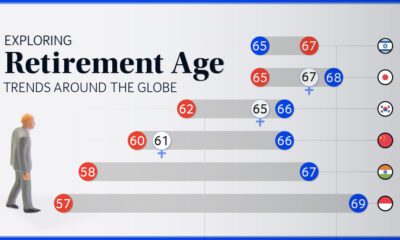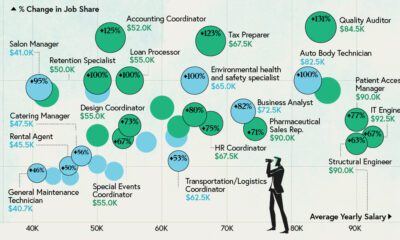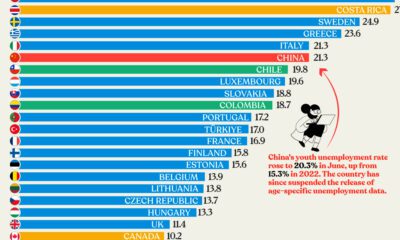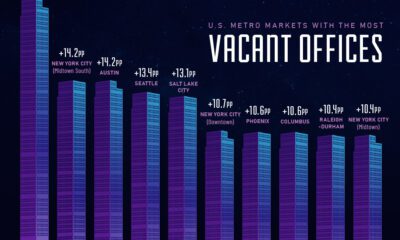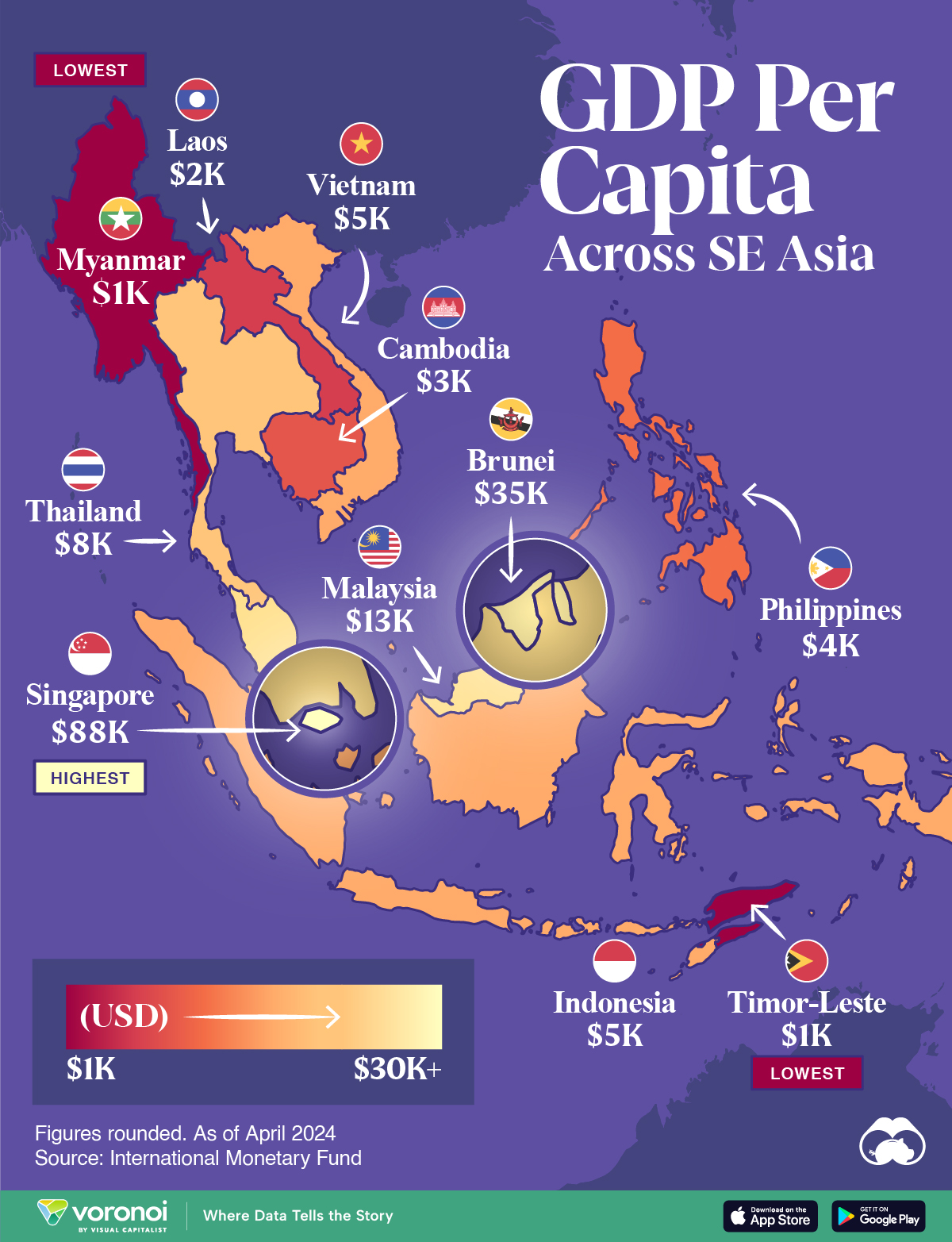Misc
Ranked: The Cities with the Best Work-Life Balance in the World
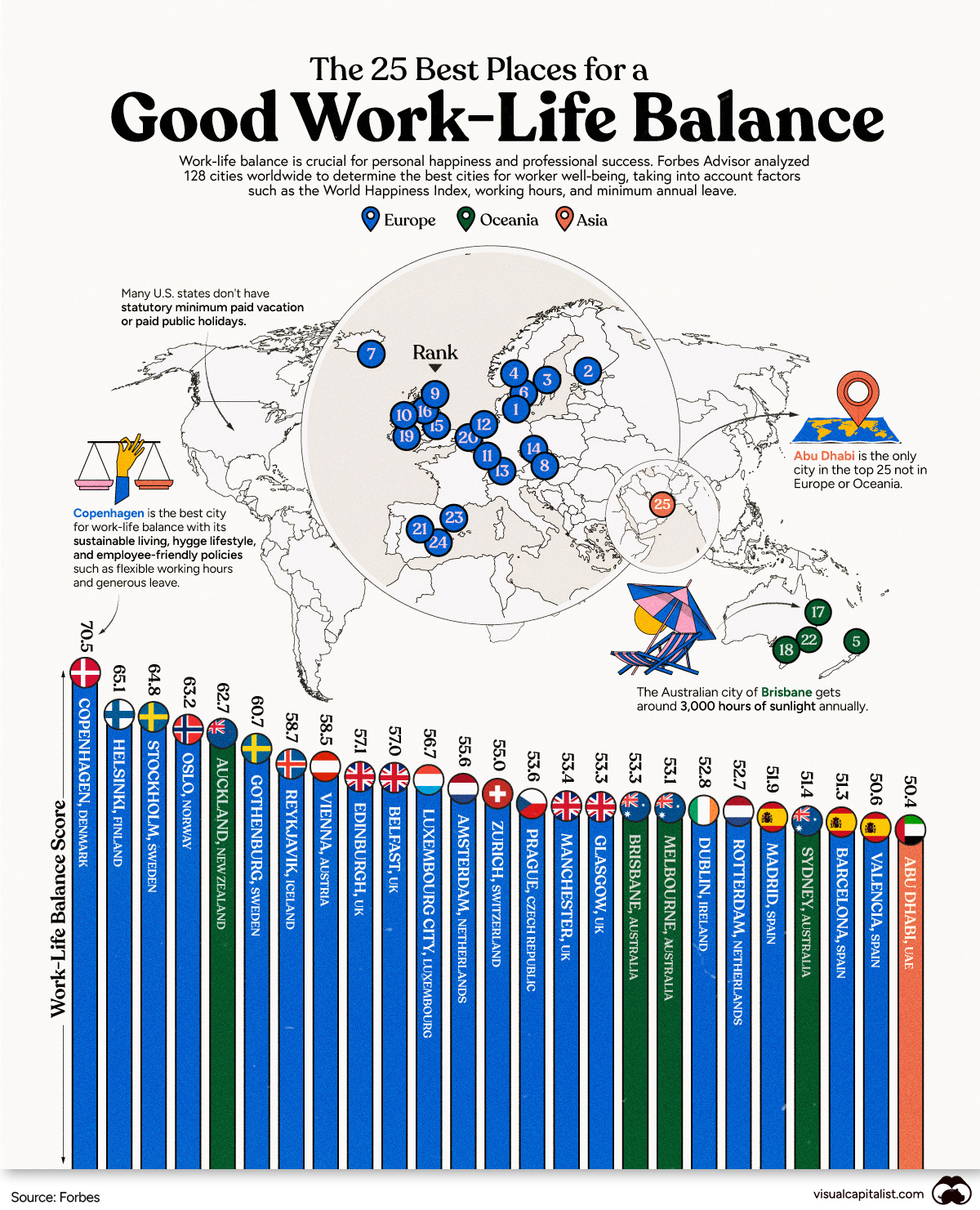
Ranked: The Cities with the Best Work-Life Balance in the World
While some careers can be relatively stress-free, maintaining a healthy work-life balance can seem impossible for many.
The easy access to technology, blurred boundaries around work and personal time, and fear of job loss push many to work overtime, and fail to use vacation time or sick leave.
However, in some cities across the world, the situation is very different. In top-ranked locales, companies offer working professionals an opportunity to maintain a work-life balance through good healthcare, ample vacation time, and so on.
In this graphic, we use the Forbes Advisor 2023 ranking to highlight the top cities in the world that encourage work-life balance. The ranking compares data from 128 cities to form the Work-Life Balance Score, which is marked on a scale of 100. The higher the score, the better work–life balance workers in a city have. We’ve covered the top 25 in the graphic above.
Europe Tops the Chart
Twenty of the 25 cities with the best work-life balance fall in Europe. The diverse range of cultures and lifestyles in these cities offers its residents a balance between work and personal life.
The top city on this list, with a work-life balance score of 70.5/100, is Copenhagen, Denmark. The city’s high standard of living, low unemployment rate, 52-week-long parental leave, and focus on sustainability and green spaces all contribute to the city’s top score. It also helps that the Danish lifestyle focuses on taking time for self-care and relaxation.
Healthy lifestyles along with generous vacation and parental leave policies also placed the European cities of Helsinki, Stockholm, and Oslo in the top five in this list. In fact, the average employee work week in these cities falls below 30 hours. The proportion of remote jobs in Helsinki, Finland is over 50%.
Many companies in Europe prioritize employee well-being, which has led to the emergence of a wellness culture. This culture includes practices such as remote work and mental health support.
Balancing Work and Life in Oceania
Although Europe dominates the top 25 list, some cities in Oceania also boast of healthy work-life balance scores.
Ranked 5th on the list of cities with the best work-life balance, workers in Auckland, New Zealand, have a 26.3-hour work week on average and a year’s worth of parental leave.
Meanwhile, the cities of Brisbane (53.3), Melbourne (53.1), and Sydney (51.4) in Australia follow an average work week of 32.4 hours to 38 hours. The sunny weather in these cities also positively influences their scores.
For Some, Safety is Key
UAE’s capital city is the only Asian city to make it to this top 25 list, and this is despite its high property prices and relatively low number of vacation days available to workers. On the flip side, the city is safe, sunny, and boasts a high quality of life.
Where Does This Data Come From?
Source: Forbes Advisor’s Work-Life Balance Index 2023
Data notes: This ranking the data from 128 cities to form the Work-Life Balance Score, which is marked on a scale of 100. The study analyzed various “Best Cities to Live In” indices, narrowing down those which had available data in the following key categories between January and February 2023. The following indices and metrics were used: World Happiness Index, Gender Inequality Index, Average working hours, minimum legal annual leave, property price to income ratio, proportion of remote working vacancies, maternity leave policies, parks and nature reserves per capita, unemployment rate, sunlight hours. Data was collected between January – Feb 2023. See the source for full details.
Economy
Mapped: Southeast Asia’s GDP Per Capita, by Country
Indonesia, the region’s largest economy, makes the top five in this map exploring Southeast Asia’s GDP per capita levels.

Mapped: Southeast Asia’s GDP Per Capita, by Country
This was originally posted on our Voronoi app. Download the app for free on iOS or Android and discover incredible data-driven charts from a variety of trusted sources.
In 1937, as America navigated the Great Depression, Russian-born economist Simon Kuznets presented a novel idea on measuring a country’s economy. And thus, gross domestic product (GDP) was born.
Nearly eight decades later, measuring GDP, and GDP per capita—which helps make data comparable between populations—has become a benchmark statistic to compare and contrast countries’ economies and productivity.
In this map, we compare Southeast Asia’s GDP per capita levels. Data is in current U.S. dollars, sourced from the International Monetary Fund’s DataMapper tool, last updated April 2024.
Ranked: Southeast Asian Countries by GDP Per Capita
Singapore stands head-and-shoulders above the rest of the region with a per capita GDP past $88,000. It is also, incidentally, one of the richest nations in the world by this metric.
The 734 km² country has only 5.6 million residents and very few natural resources. However the country’s strategic location makes it a center for trade and commerce.
| Country | GDP Per Capita |
|---|---|
| 🇸🇬 Singapore | $88,450 |
| 🇧🇳 Brunei | $35,110 |
| 🇲🇾 Malaysia | $13,310 |
| 🇹🇭 Thailand | $7,810 |
| 🇮🇩 Indonesia | $5,270 |
| 🇻🇳 Vietnam | $4,620 |
| 🇵🇭 Philippines | $4,130 |
| 🇰🇭 Cambodia | $2,630 |
| 🇱🇦 Laos | $1,980 |
| 🇹🇱 Timor-Leste | $1,450 |
| 🇲🇲 Myanmar | $1,250 |
Note: Figures are rounded.
This is in sharp contrast to Brunei, Southeast Asia’s next richest country, with a per capita GDP of $35,110.
Oil is a critical part of Brunei’s economy, making it both very wealthy, but landing it in a vulnerable, resource-dependent position. Oil and gas revenues contribute half the country’s entire revenue receipts.
Two countries known for their large tourism sectors, Malaysia and Thailand rank third and fourth, at $13,310 and $7,810 respectively.
Finally, Southeast Asia’s largest economy, and the world’s fourth-most populous country Indonesia, rounds out the top five with a GDP per capita of $5,270.
-

 Brands5 days ago
Brands5 days agoThe Evolution of U.S. Beer Logos
-

 Culture2 weeks ago
Culture2 weeks agoThe World’s Top Media Franchises by All-Time Revenue
-

 voronoi2 weeks ago
voronoi2 weeks agoBest Visualizations of April on the Voronoi App
-

 Wealth2 weeks ago
Wealth2 weeks agoCharted: Which Country Has the Most Billionaires in 2024?
-

 Business1 week ago
Business1 week agoThe Top Private Equity Firms by Country
-

 Markets1 week ago
Markets1 week agoThe Best U.S. Companies to Work for According to LinkedIn
-

 Economy1 week ago
Economy1 week agoRanked: The Top 20 Countries in Debt to China
-

 Politics1 week ago
Politics1 week agoCharted: Trust in Government Institutions by G7 Countries






